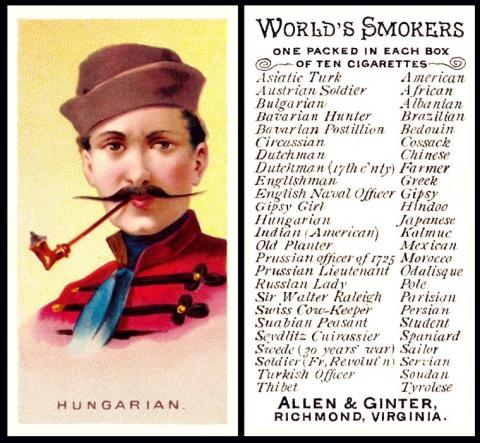
A super card, and guess what, a Hungarian is a type of moustache as well as a smoker - according to the experts, this style is large and bushy, completely obscuring the upper lip. The sides are sometimes curled, resembling a large handlebar, and sometimes they are curled down like a walrus. Our card confuses this a bit because although it does indeed cover that top lip, it is straight at the ends.
I have to say I have really enjoyed researching all these moustaches, there are some great pictures out there...
Now there are a lot of codes up there, and we have also made a bit of a space saving change as we have RB.[1]18 listed. This is the Tobacco War Booklet, which was originally issued as RB.18 in 1951, but was reissued and updated as RB.118 "later on" (because I forgot to write that date down). USA/33 is from the Burdick Catalogue, in which they are valued at just fifteen cents a card.
Remember that "Bk" means backlisted, where all the cards in the series are listed on the reverse of every card, quite a useful idea really for you know when you have them all, and also you immediately get drawn to certain cards making your hunt more exciting.
And the cards measure 70 x 38 m/m, just slightly larger than standard.
By the way this set was never issued as a printed album in which all the cards in the set appeared, or at least I have not been able to track one down in any records. If you know of one do let us know.
There is one more exciting thing, as it turns out that Allen and Ginter were not the only issuer of these lovely cards -
In 1900, Japanese smokers got to collect them, courtesy of Murai Bros, who were based in Kyoto. Murai is a very interesting company because they started with tobacco, then travelled all the way to America to learn how to make cigarettes, training which enabled them to produce and sell the first brand of cigarettes ever sold in Japan. This was in 1894. They seem to have kept in touch with America and three years later amalgamated with an American company to form Murai Bros. However this did not last too long, through no fault of their own - in 1904, during the Russo Japanese War, the production and sale of tobacco all across the country was taken over by the Japanese Ministry of Finance.
These cards are un-numbered and though I have not been able to examine all the cards it appears that they all have additional advertising on the front to say "MURAI`S CIGARETTES are the BEST and CHEAPEST". They have a blue back which will appear on here as soon as I can. Until then it is blue and the top says "A DIFFERENT CARD IN EVERY PACKAGE OF CIGARETTES" without mentioning anything about how many that is. In the middle it says "MURAI BROS. & Co. / KYOTO, JAPAN" in two lines. And below that are Japanese characters - anyone out there who can translate this please do, it would be interesting to see what it says, because it could point to the target smoker being both English and Japanese. Also whilst I am asking for assistance, if anyone has a Hungarian in this Murai printing I would appreciate a front and back to add in here. By the way they are recorded as being slightly different in size 70 x 37 m/m. And the codes on this set are M953-090 and M156-7.
Their second appearance came in 1904, or maybe in 1910, I have both dates more than once. This was over in Canada, in packets of Dominion Tobacco Co., who were based in Montreal. The curious thing here is that they are reported as having a slightly different name, this being "The Smokers of the World". Actually this is not really true, the back is untitled, but the text says "50 DIFFERENT DESIGNS OF THESE CARDS, ILLUSTRATING THE SMOKERS OF THE WORLD PACKED WITH THESE CIGARETTES." The fronts are also slightly different, with the smoker`s name in upper and lower case, rather than all capitals. There were also two printings, the first, usually recorded as (A.) black backed with a series title, and the second being (B.) brown backed with no title. They are slightly different in size to the Allen and Ginter but identical size to the Murai, at 70 x 37 m/m. The codes on this set, adding the A and B respectively, are D635-700 and D50-2
Now it turns out that they were also issued with plain backs and neither title nor issuers name. This seems to be credited to Teofani, some time in the mid 1920s. I will be researching this next. All help gratefully recieved
